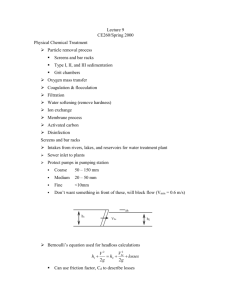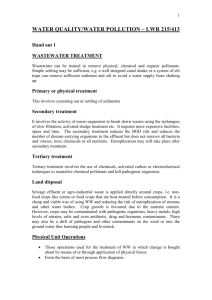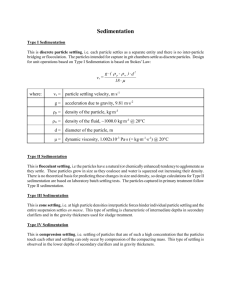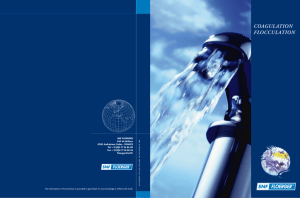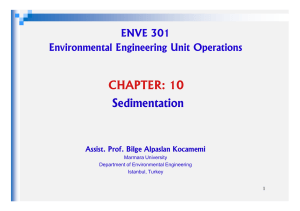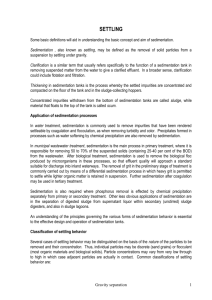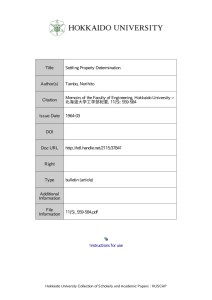File
advertisement
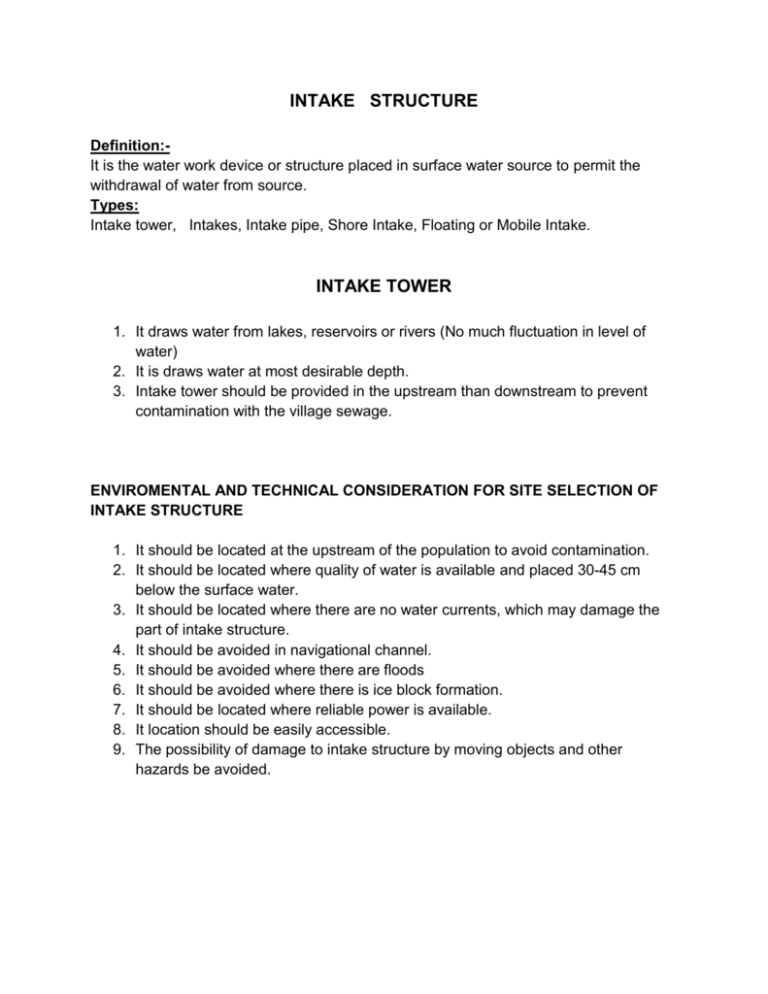
INTAKE STRUCTURE Definition:It is the water work device or structure placed in surface water source to permit the withdrawal of water from source. Types: Intake tower, Intakes, Intake pipe, Shore Intake, Floating or Mobile Intake. INTAKE TOWER 1. It draws water from lakes, reservoirs or rivers (No much fluctuation in level of water) 2. It is draws water at most desirable depth. 3. Intake tower should be provided in the upstream than downstream to prevent contamination with the village sewage. ENVIROMENTAL AND TECHNICAL CONSIDERATION FOR SITE SELECTION OF INTAKE STRUCTURE 1. It should be located at the upstream of the population to avoid contamination. 2. It should be located where quality of water is available and placed 30-45 cm below the surface water. 3. It should be located where there are no water currents, which may damage the part of intake structure. 4. It should be avoided in navigational channel. 5. It should be avoided where there are floods 6. It should be avoided where there is ice block formation. 7. It should be located where reliable power is available. 8. It location should be easily accessible. 9. The possibility of damage to intake structure by moving objects and other hazards be avoided. TREATMENT OF WATER Water is treated before drinking, industrial and other uses. Degree of treatment depend s upon quality of water (raw) and quality of treatment. 20 NTU Raw water 5 NTU Degree of Treatment= (Raw-Required) = (20-5) = 15 degree. Purpose:1. 2. 3. 4. To remove harmful bacteria To remove the unpleasant odor & taste To remove the excessive turbidity & Color To remove the dissolved solids & chemicals. METHOD OF PURIFICATION 1. 2. 3. 4. 5. 6. 7. 8. 1. 2. 3. 4. 5. 6. Screening Plain Sedimentations Sedimentation aided with Coagulation Filtration Disinfection Aeration Softening Miscellaneous treatments like Fluoridation, Recombination, Desalination etc. SCREENING They exclude hard objects i.e. debris, animal, trees, branches, bushes, ice etc. They are two types a. Coarse screen trash racks b. Fine Screens Coarse screen consist of parallel placed vertically or at slope to about 2-10cm center to center (40-60C water surface) Fine Screen is made of fine wire or perforated metal with opening less than 1cm wide. Corse screens remove floating bodies & organic solids & fine screen remove fine S.S (suspended solid) When Screens are clogged, they are clean by rakes. The solid accumulated in screen are called screenings. Assignment Draw Diagram of Screen from book PLAIN SEDIMENTATION It is defined as removal or separation of S.S from water by gravity. The tank in which sedimentation takes place is called sedimentation or settling tanks or clarifiers. Clarifier is designed to reduce the velocity of lowing water They remove 60% of S.S and 75% of bacterial load. Factor affecting Rate of Sedimentation 1. 2. 3. 4. Characteristics of S.S (size, shape & specific gravity) Concentration of S.S Velocity of low Viscosity of water / Temperature of water Inorganic particles Ss > 1.2 easily settle Inorganic particles Ss < 1.2 will not settle easily STROKE’S LAW Vp= (g/18v) *(Sp-1) dp2 Vp = velocity of setting Particle v = viscosity of water (neu) Sp=specific gravity of S.S (1.04-2.64) dp = diameter of S.S 1. 2. 3. 4. TYPES OF SEDIMENTATION Depend on the characteristics and concentration of S.S Type I Settling (Discrete particle settling) Type II Settling (Flocculent particle settling) Type III Settling (Zone settling) Type IV Settling (Compression settling) 1. Type I Settling (Discrete particle settling) Particle settles as individual entities without any interaction with each other. This principle of plain sedimentation where no coagulation is required Occur in dilute solution 2. Type II Settling (Flocculent particle settling) Particles are attached to each other to form a floc which settles as mass Combination of particles is due to their own interactive forces or may be due to some coagulant (chemical) like Alum, CuSO4 etc. 3. Type III Settling (Zone settling) Particles interact in such that they remain in their fixed position w.r.t each other and settle as a single unit so that clear interface is visible Occur in particles of intermediate concentration 4 Type IV Settling (Compression settling) When the S.S concentration is sufficiently high that particles are in permanent contact with each other, then further settlement is slow and related to weight of suspension only. Occurs in lower layers of deep sludge mass of final sedimentation tank Types of Sedimentation Tank Working Shape FILL AND DARW TYPE Fill and Draw Continuous Rectangular Circular Hoppe bottom It is an intermittent type It stores the water for certain time (24hrs) in which S.S settles down to the bottom of tank, the clear water is drawn off and settled silt/S.S is cleaned. Min. numbers of 3 tanks are required for single unit. Now days, they are out of use because Required labor and expert supervision for filling, emptying and washing Lot of time is wasted. (Figure) More units are required. CONTINUOUS FLOW TYPE S.T Flow velocity of water is reduced (No complete rest as the velocity is reduced by providing sufficient length of travel. This can be done by providing baffle wall having opening at different level, to allow the particles to settle down by reducing velocity. Total amount of flow in 24 hrs =Daily demand of water. CLASSIFICATION ON THE BASIS OF SHAPE 1. Rectangular with horizontal flow 2. Circular tank with radial flow 3. Hopper Bottom tank with vertical flow Rectangular Types: Continuous or intermittent (depth=12’) Common type with or without baffle (walls) L: W=2:1 to 4:1 Slope of floor = 1 in 40 Circular Types: Centrally or peripherally fed with rdial or spiral flow Dia =31 m with S.O.R=1500 l/m2/hr S.O.R =Surface over Flow rate Hopper Bottom Tank: Bottom is in the form of hopper and flow is vertical (Down to up) Sludge is cleaned by raking arm and drawn off through outlet. (Figure) INLET: Reduce the entrance velocity to prevent current towards the outlet Distribute water uniformly across the depth & width. Mixes incoming water to water already present in the tank to prevent density of currents. OUTLET: It should prevent high approach velocity near outlet It should be as far from inlet as possible. SCOUR VELOCITY: The horizontal velocity of water just sufficient to re-suspend the settled particles is known as Vs. ASSIGNMENT TYPES OF INLETS & OUTLETS INLETS 1. Submerged Inlets 2. Submerged inlet with chamber OUTLETS 1. Outlet with Draw off channel 2. Out let with floating Arm DESIGN OF SEDIMENTATION TANK Design criteria is based on 1. Over flow rate 2. Detention time For discrete particles only UNDER IDEAL CONDITIONS Complete mixing and uniform suspension at inlet/entrance zone Uniform horizontal velocity (Vw) in settling zone No flocculation i.e discrete settling The particles that reach the bottom of tank are permanently removed. SOR or OR or Vp It is numerically equal to the flow divided by the plain area of the tank but which physically represent the settling velocity Vp of the slowest particle which is 100% removed. Detention Time(td): Vp=Vw (D/L) (Explanation) Td is the time for which water is allowed to remain in sedimentation tank. Generally 3- hours Over flow rate 24-25 m3/day 1. 2. 3. 4. 5. 6. 7. DESIGN CRITERIA Select Vp (over flow rate) as 24-25 24-25 m3/ m2d Detention time td= 3-8 hours generally 3 hrs Depth D= 2-6 m Slope (bottom) ----8% Sludge storage capacity ---20% total depth Weir over flow rate or weir loading rate = 250 m3/ m2d Min. number of tank =2 COAGULATION & FLOCCULATION COAGULATION:Coagulation is the process of combining many small particles into few large ones or mass to facilitate the settling of very fine particles. The fine particles take much time to settle down. It is the process of destabilization of colloidal particles. FLOCCULATION:It is the process of particles transport phenomenon in order to ensure inter-particles contact. It is defined as slow mixing technique which permits agglomeration of destabilized particles. Slow mixing----- Flocculation Q. Why Coagulation is practically needed? Ans: 1. 2. 3. 4. 5. DIFFERENT TYPES OF COAGULANTS Aluminum Sulphate Ferrous Sulphate Sodium Aluminate Ferric Sulphate Ferric Chloride Q. How can we make large particles or mass?. Ans:- STABLE SUSPENSION In which the particles (silt, clay, bacteria) do not aggregate or agglomerate. These particles are negatively charged, they repel each other. By electromagnetic repulsion they are in fixed position. In stable suspension particles agglomerate very slowly.


